see page 37.

Resilient Seas
How the oceans can counter climate change, with our help
Sanctuaries Won
The marine habitats Oceana has preserved, in photos
Meet SeaChange’s Chair
SPRING 2020 OCEANA.ORG
Magazine
Entrepreneur Elizabeth Wahler leads one of Oceana’s top events
British investment banker Lord Jacob Rothschild welcomed Oceana’s Board to a reception at Spencer House, the 18th-century London palace that was carefully restored under Lord Rothschild’s chairmanship. For photos of the event,
© Waddesdon Image Library
Board of Directors
Valarie Van Cleave, Chair
Ted Danson, Vice Chair
Diana Thomson, Treasurer
James Sandler, Secretary
Keith Addis, President
Gaz Alazraki
Monique Bär
Herbert M. Bedolfe, III
Nicholas Davis
Sydney Davis
César Gaviria
Mária Eugenia Girón
Loic Gouzer
Jena King
Sara Lowell
Stephen P. McAllister
Kristian Parker, Ph.D.
Daniel Pauly, Ph.D.
David Rockefeller, Jr.
Susan Rockefeller
Simon Sidamon-Eristoff
Rashid Sumaila, Ph.D.
Sam Waterston
Jean Weiss
Ocean Council
Susan Rockefeller, Founder
Kelly Hallman, Vice Chair
Dede McMahon, Vice Chair
Anonymous
Samantha Bass
John and Violaine Bernbach
Rick Burnes
Marcella Cacci
Vin Cipolla
Barbara Cohn
Ann Colley
Edward Dolman
Susanne Elstein
Kay Fernandez
Marsha Garces Williams
Brian and Linda Gold
Chris and Carolyn Groobey J. Stephen and Angela Kilcullen
Ann Luskey
Peter Neumeier
Carl and Janet Nolet
Ellie Phipps Price
David Rockefeller, Jr.
Andrew Sabin
Elias Sacal
John and Regina K. Scully
María José Pérez Simón
Sutton Stracke
Vivien Sylvester
Mia M. Thompson
Dr. David Treadway
Edgar and Sue Wachenheim III
Valaree Wahler
David Max Williamson
Raoul Witteveen
Leslie Zemeckis
Oceana Magazine is published by Oceana Inc. For questions or comments about this publication, or to subscribe to Oceana Magazine, please call our membership department at +1.202.833.3900, email membership@oceana.org or write Oceana, Member Services, 1025 Connecticut Ave. NW, Suite 200, Washington, DC 20036 USA.
Oceana Staff
Chief Executive Officer Andrew Sharpless
President Jim Simon
Chief Policy Officer, North America Jacqueline Savitz
Chief Scientist Katie Matthews, Ph.D.
Senior Vice President, Strategic Initiatives Matthew Littlejohn
Vice President, Belize Janelle Chanona
Vice President, Brazil Ademilson Zamboni, Ph.D.
Executive Director, Oceana Canada Joshua Laughren
Vice President, Chile Liesbeth van der Meer
Executive Director and Vice President, Oceana in Europe Pascale Moehrle
Acting Vice President, Mexico Renata Terrazas
Vice President, Peru Patricia Majluf, Ph.D. Vice President, Philippines Gloria Estenzo Ramos, J.D. Vice President, Development Nancy Golden
Chief Financial Officer Christopher Sharkey
Deputy Vice President, U.S. Pacific Susan Murray
Senior Advisor Michael Hirshfield, Ph.D.
Oceana’s Privacy Policy: Your right to privacy is important to Oceana, and we are committed to maintaining your trust. Personal information (such as name, address, phone number, email) includes data that you may have provided to us when making a donation or taking action as a Wavemaker on behalf of the oceans. This personal information is stored in a secure location. For our full privacy policy, please visit Oceana.org/privacy policy.
Editorial Staff Editor
Please Recycle.
Emily Petsko Designer Alan Po
FSC Logo
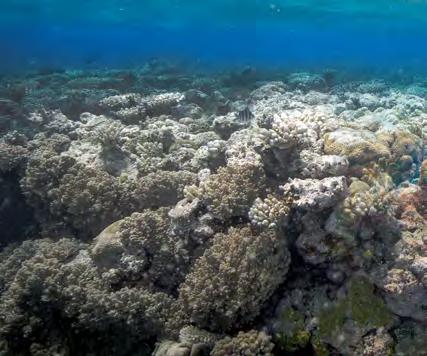

Features Contents To help navigate Oceana’s work, look for these five icons representing our five major campaigns. Curb Pollution Stop Overfishing Reduce Bycatch CEO Note Oceana’s country by country approach gets the job done, despite political turmoil For the Win A legal milestone in Chile, progress towards a U.S. shark fin trade ban, and more News & Notes Seafood fraud shown in three countries, Canada’s fish populations decline, and more Q&A Dr. Malin Pinsky on becoming an Oceana Science Advisor and researching marine ecosystems
Seas Climate change is hurting the ocean, but Oceana is helping the ocean fight back Sanctuaries Won A snapshot of Oceana’s habitat protections around the world Oceana’s Victories Looking back at our big wins over the last year Supporter Spotlight Entrepreneur and marketing whiz Elizabeth Wahler is the new SeaChange chair Ask Dr. Pauly What is ecosystem-based fisheries management? Events Our Ocean 2019, a plastic seminar in Switzerland, and two London receptions Chef’s Corner Mark Bittman’s recipe for seared sea scallops Parting Shot Swimming above a meadow of Neptune grass 3/ 4/ 6/ 10/ 8/ 22/ Protect Habitat Increase Transparency 30/ 31/ 32/ 34/ 38/ 40/ Climate change and the oceans 10 Protecting habitats around the world 22 © Shutterstock/Imagine Earth Photography © Oceana/Carlos Minguell 1
Resilient
Your support makes an ocean of difference
Please Give Generously Today
A healthy, fully restored ocean could sustainably feed more than 1 billion people each day.
Call us today at (202) 833-3900, email us at info@oceana.org, visit www.oceana.org/give, or use the envelope provided in this magazine to make a donation. Oceana is a tax-exempt 501(c)3 organization and contributions are taxdeductible to the fullest extent of the law.
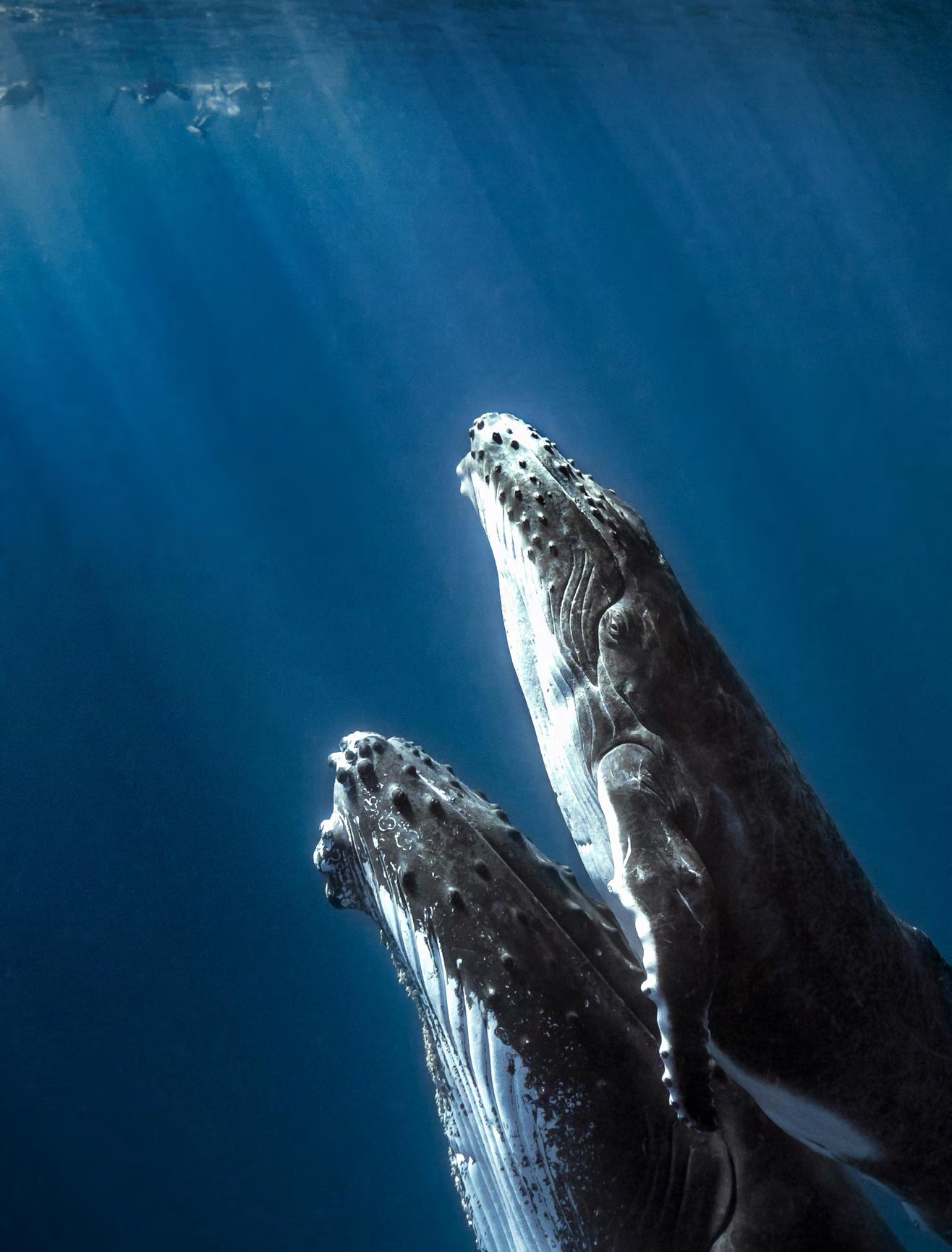
© Shutterstock/Seb c’est bien
Oceana saves the oceans country by country. This might seem surprising, since the map of the world’s oceans makes it look like a highly international place.
Our approach is rooted in the fact that most of the world’s fish, and most of its biodiversity, are in the coastal zones that are under national control.

These zones, called Exclusive Economic Zones (or EEZs, for short), extend out to 200 nautical miles. They are recognized under international law as zones in which the coastal country, typically without any international consultation, sets and enforces rules on ocean fishing and other ocean resource extraction, such as oil drilling or undersea mining.
To win national ocean conservation policies country by country, Oceana assembles small teams of advocates in countries whose EEZs are strategically important to the global productivity and diversity of the world’s oceans.
All our teams are composed of citizens from those countries. This is important because the conservation policies we seek are good for the coastal country
as well as good for the world. It’s also important because our campaigners are on their home turf, and so they know the nuances of how to win.
So, while we are highly diverse, we are one global organization. We have grown to include people campaigning in 10 key ocean countries, and together, these countries control about 30% of the world’s wild fish catch each year.
Across all our countries, our policy advocates are facing extraordinary political events, and in some cases, even turmoil. The United States is heading into what will almost certainly be a hyper-partisan election year. Britain and Europe have just finished a Brexit-fueled round of high stakes politics.
In Chile, street protests involving millions of people challenge assumptions about the balance of power in that important ocean country (which is always listed among the top 10 most important fishing nations in the world). I could go on.
You will be relieved to learn that these unusual times have not stopped us from continuing to deliver policy
outcomes that stop overfishing, protect ocean habitat, reduce ocean pollution, and drive the transparency that deters illegal fishing. You will enjoy reading about a new set of policy victories in this decade’s first issue of our thrice-yearly magazine.
Ocean conservation has been an area in which steady progress is possible despite political tumult. This tradition is even evident in the name of the fundamental U.S. law on ocean fishing, which is called the MagnusonStevens Act after the Democratic and Republican senators who insisted on modern science-based fishery management.
With your continued support, Oceana continues to win for the oceans, despite these highly partisan times. Thank you for your generous support. Please take courage, and confidence, from the good news reported in these pages.

For the Oceans,
 Andrew Sharpless CEO Oceana
Andrew Sharpless CEO Oceana
SPRING 2020 | Oceana.org3
CEO Note
© iStock/Vaara
For the Win
Buckets are filled with longlines aboard a fishing vessel in Sicily, Italy. Up to 1,200 hooks can be attached to the main line, posing a deadly and indiscriminate threat to many marine animals.
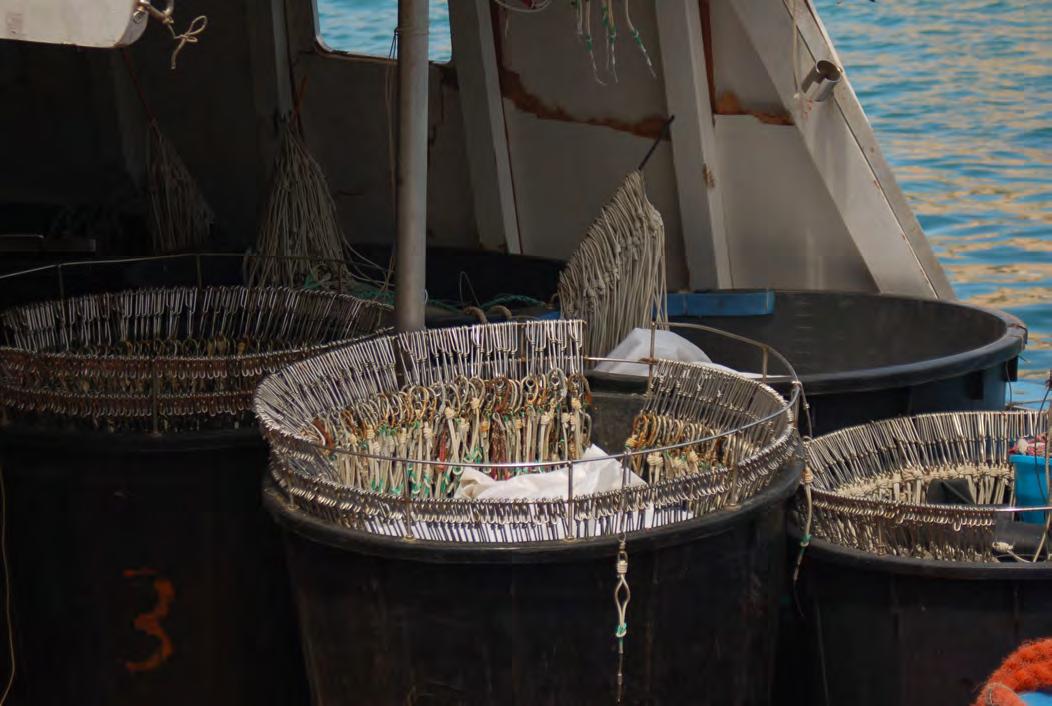
Fishery council rejects harmful longline fishery off U.S. West Coast
The Pacific Fishery Management Council voted overwhelmingly against the return of a West Coast-based pelagic longline fishery targeting swordfish on the high seas. Pelagic longlines, which have been banned off of California’s coast for nearly 40 years, contain thousands of baited hooks and stretch for up to 100 kilometers (60 miles). They are left to soak in the water overnight, resulting in high rates of bycatch and ensnaring sharks, seabirds, marlins, marine mammals, and critically endangered sea turtles.
Despite facing pressure from NOAA Fisheries to expand the use of pelagic longlines, the council sided with Oceana and its allies, ecotourism operators, members of Congress, and the state of California, which played a key role in securing this latest protection for marine life.
Oceana provides public access to Mexico’s commercial fishing data for first time
Mexico’s commercial fishing data can now be viewed anywhere in the world, thanks to Oceana’s efforts to provide free online access to this crucial information on the Global Fishing Watch platform.
This data, recorded by satellite, covers more than 2,000 vessels in Mexico’s industrial fleet. Previously, only 34 vessels had data on public record. Oceana was able to access a more complete dataset after the National Access to Information Institute (INAI) ruled that this information was of public interest and should be made available.
Visit globalfishingwatch.org/map/workspace/mexico to see the data.
4
4
© Oceana/María José Cornax
Chile’s Supreme Court sides with Oceana in Dominga mining case
Last September, Chile’s highest court sided with Oceana when it dismissed arguments presented by Andes Iron in support of the proposed Dominga mining and port development project. Andes Iron wants to mine La Higuera, a coastal municipality in northern Chile, for copper concentrate and iron. Oceana has demonstrated that this project would put vulnerable and endangered marine species in harm’s way, including Humboldt penguins, which are endemic to South America’s Humboldt Current and primarily found in north-central Chile.
This case has been tied up in the courts for years, and the Supreme Court’s decision now remands it to Chile’s Environmental Court for a new trial in March 2020. The case could go back to the Supreme Court once again if it’s challenged, but for now at least, the mining project is delayed and the Humboldt penguins are safe.

The U.S. House of Representatives passed bipartisan legislation last November that would make it illegal to buy and sell shark fins in the United States, following three years of campaigning by Oceana. The Shark Fin Sales Elimination Act now awaits passage in the Senate.
Each year, fins from up to 73 million sharks enter the global trade, decimating many shark populations. A U.S. prohibition on the trade of shark fins will improve enforcement of the current ban on finning in U.S. waters. Oceana previously won victories in Peru, which banned the landing of shark fins in 2016, and in Canada, which became the first G20 country to ban the shark fin trade last summer.
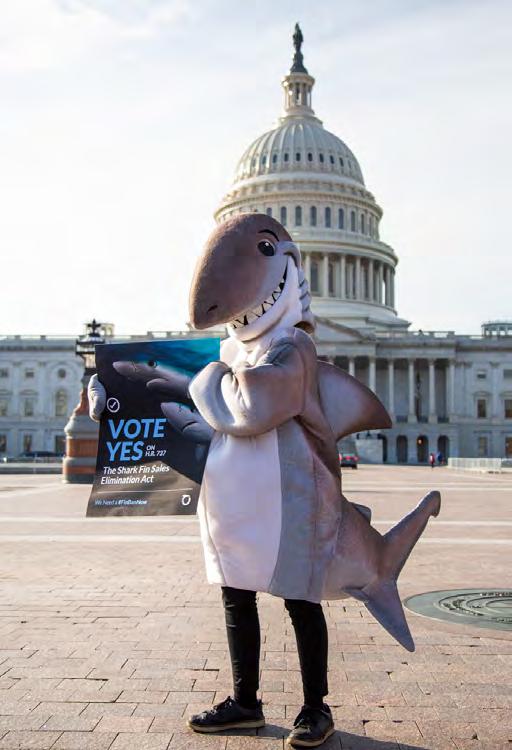
SPRING 2020 | Oceana.org5
Shark fin trade ban passes U.S. House vote, heads to Senate
Humboldt penguins are a vulnerable species, according to the IUCN Red List. Their numbers in Chile have dwindled since the 19th century due to habitat changes and commercial activities.
5
Oceana’s shark-championing mascot, Dusky, visited the U.S. Capitol the day before the House voted in support of the Shark Fin Sales Elimination Act. The bill was cosponsored by 287 representatives.
© Oceana/Patrick Mustain
© Oceana/Max Bello
News + Notes
Oceana Board Vice Chair Ted Danson urged lawmakers to “stop the runaway increase” in single-use plastic production while testifying in a House Natural Resources Subcommittee on Water, Oceans, and Wildlife hearing last October.

“Companies need to significantly reduce the amount of single-use plastic they are putting onto the market and offer consumers plasticfree choices for their products. Unfortunately, companies aren’t doing enough, and that’s why we need your help,” Danson said during the hearing, which was titled “A Sea of Problems: Impacts of Plastic Pollution on Oceans and Wildlife.”
Oceana’s international plastics campaign urges companies to reduce the amount of single-use plastics they produce, and also advocates for policies that ban or limit single-use plastics.
DNA testing shows seafood fraud is rampant in Canada, Peru, and Mexico
Sampled seafood products in Canada and Peru were mislabeled more often than not, according to two Oceana studies that were released last fall.
First, Oceana’s DNA analysis in Montreal, Canada revealed that 61% of the tested seafood samples were mislabeled. Then, Oceana’s research in Peru found that 72% of tested samples were mislabeled in the cities of Lima, Chiclayo, and Piura. A third Oceana report, released around the same time,
Ted
“If plastic was a country,
showed that 31.5% of “cod” samples tested in Mexico City were rays, tilapia, other finfish, and a variety of sharks on the IUCN Red List.
Seafood fraud can perpetuate demand for species that are already overexploited. Abundant (and less popular) species of fish are often passed off as vulnerable (but more desirable) ones, creating the illusion that depleted species are widely available when they aren’t.
Thanks to Oceana’s work on transparency initiatives, the Canadian government recently committed to developing a boat-toplate traceability program, marking
an encouraging step towards ending seafood mislabeling throughout the country.
Canada’s fish populations declined over the last three years, Oceana report finds
Canadian waters contain more critically depleted fish stocks – and fewer healthy ones – than three years ago, according to Oceana Canada’s latest Fishery Audit.
The Audit came just months after the government’s landmark decision to overhaul its Fisheries
6
Ted Danson testifies at U.S. House hearing on plastic pollution
Danson also addressed the connection between plastics and climate change in his testimony, stating,
it would be the planet’s fifth-largest emitter of greenhouse gases.”
© Oceana/Kaemmerling Photography
The health status of Canada’s fish populations in 2019
29.4% 15.5% 17% 38.1%
Healthy Biomass is more than 80%
Act and create a legal imperative to rebuild ocean abundance.
The number of marine stocks in a critical state now stands at 17%, marking a 3.6% increase from 2017. Meanwhile, healthy populations have become even more uncommon, representing just 29.4% of Canada’s fish stocks (down 5.1% from 2017).
The Scotian Shelf snow crab and three kinds of Pacific shrimp are among the species that moved into the critical zone, and if these declines continue, it could hurt the livelihoods of the many Canadians who depend on crustacean fisheries. Crab, lobster, and shrimp account for more than 74% of all landings in Canada (by value).
Oceana calls on the government to establish strong regulations and rebuilding plans that fulfill the intent of the amended Fisheries Act.
Cautious Biomass is between 40-80%
Critical Biomass is less than 40%
90% of U.S. West Coast waters now protected from bottom trawling
NOAA Fisheries recently issued final regulations to protect more than 360,000 square kilometers (140,000 square miles) of vibrant and diverse seafloor habitats off the coasts of California, Oregon, and Washington from destructive bottom trawls.
Combined with previous gains made by Oceana, 90% of West Coast waters, from shore to 370 kilometers (230 miles) off the coast, are now safeguarded.
This win was a long time in the making. Following years of scientific input and campaigning by Oceana, the Pacific Fishery Management Council voted in April 2018 to recommend new and modified conservation areas to be closed to bottom trawling.
Uncertain
Not enough information to classify
They also voted to protect a massive deep-sea ecosystem off California from all commercial fishing gears that contact the seafloor. NOAA Fisheries approved the council’s recommendations and finalized the regulations that enforce those protections.
The protected areas include underwater canyons, newly discovered glass sponge reefs, and gardens of rare black corals.
“Until recently, these deep-sea corals and sponges were unknown to mankind,” said Ben Enticknap, Pacific campaign manager and senior scientist at Oceana, “and there’s still so much more about the deep ocean that remains a mystery.”
To read more about how these protections will benefit Southern California and the diverse species that live there, check out the habitat feature on page 22.
SPRING 2020 | Oceana.org7
Dr. Malin Pinsky is an ecologist and evolutionary biologist who holds a Ph.D. in biology from Stanford University. He is currently an Associate Professor within the Department of Ecology, Evolution, and Natural Resources at Rutgers University in New Brunswick, New Jersey, where he heads up the Global Change Ecology and Evolution lab. His team of 17 researchers studies ongoing and projected changes in the ocean, including the effects of climate change on fish and other marine species. As an Oceana Science Advisor, his guidance and expertise help inform Oceana’s “Save the Oceans, Feed the World” campaign.
Dr. Malin Pinsky on becoming an Oceana Science Advisor
Of all the biology concentrations, why did you choose to pursue a career in marine ecology?
MP:
I didn’t start out as a marine ecologist, but I became fascinated with the field after college, following a couple of key experiences. First was a chance to work as a field technician on a research vessel in Antarctica. The marine wildlife were just stunning. The ocean surface looks pretty featureless, but it hides such rich diversity that becomes apparent once you know what to look for. Secondly, during an internship with Oceana in 2003, I realized that there was a real need for new science to guide ongoing ocean conservation and ocean policy. The ocean isn’t an endless resource that can keep giving and giving.
You mentioned your internship at Oceana’s Washington, D.C. headquarters. What stands out in your memory from your time there?
MP:
I learned so much in those few months about the relationship between science and public policy.
During my first couple of months, I helped out on Capitol Hill and advocated for increased funding for the federal fisheries observer program. I vividly remember a conversation with a Republican staff member who pointed out that her boss would be happy to support marine conservation as long as we could link it to military readiness. She even gave an example: Certain limits to offshore drilling would leave more space for Air Force training. That helped me see that conservation isn’t – or at least doesn’t have to be – partisan. I also learned that I didn’t want a career wearing a suit and lobbying! It helped bend my career back towards science.
Fifteen years later, you became an Oceana Science Advisor. What brought you back?
MP: I got into science and research because I want to be able to inform more effective conservation in the ocean. I don’t want my research to simply end up in published papers that a handful of other researchers read. Working with Oceana is a great opportunity to make our research useful.

8 Q+A
Your research tends to focus on ocean ecosystems in a state of flux. What changes have you witnessed over the last decade?
MP: Many of the most dramatic changes we’ve seen have to do with marine animals on the move. Some species have extended hundreds of miles further north, while others, like lobster, have largely disappeared from southern New England.
How do marine animals differ from land animals in their response to climate change?

MP: One of the biggest differences we’ve seen is that marine species are like the proverbial canary in the coal mine. They’re often
disappearing faster and shifting their ranges faster than species on land. Part of the reason is that it’s pretty hard to escape warming water as an ocean animal. They can’t duck into the shade or find cool spots as easily as can animals on land, and their body temperatures pretty much match water temperatures.
It’s no secret that marine ecosystems are facing an array of problems, including but not limited to climate change. Have you observed anything that gives you hope for a better future for our oceans?
MP: The headlines in the news tend to be pretty grim, but that actually obscures a lot of success stories
out there that don’t get as much attention. Fisheries in the U.S., for example, are largely doing well, including many overfished species that have now been rebuilt. The fact that recovery is possible, and even happens quickly in some cases, really gives
hope.
What are you working on now?
MP: I’m concerned about the impacts of climate change on coral reefs. Corals face a pretty bleak future with ocean warming, but one of our projects right now is trying to figure out designs for marine protected areas that would help facilitate the evolution of corals to make them more resilient in warmer waters.
SPRING 2020 | Oceana.org9
Madeira rockfish are a common sight along the coast of North Africa and parts of the Mediterranean. However, researchers say the species has been shifting further north, towards Spain and Portugal, likely as a result of warming waters.
© Oceana/Carlos Minguell
The headlines in the news tend to be pretty grim, but that actually obscures a lot of success stories out there that don’t get as much attention. Fisheries in the U.S., for example, are largely doing well, including many overfished species that have now been rebuilt. The fact that recovery is possible, and even happens quickly in some cases, really gives me hope.
– Dr. Malin Pinsky, Oceana Science Advisor
“
me
“
Climate change is hurting the ocean.
The science is clear: Our seas are rising, heating up, and acidifying at ever-faster rates. As the world’s largest “carbon sink,” the ocean absorbs a colossal amount of man-made emissions and heat, setting off a series of reactions that hurt marine ecosystems.

Feature
© Oceana/Carlos Suárez
But the ocean is fighting back.
Though it is a victim in this story, it is also a protagonist of positive change. Here are three ways that Oceana is helping the ocean save itself – and all of us – from the harsh realities of a planet in flux.
 © Oceana/Juan Carlos Calvin
© Oceana/Juan Carlos Calvin
There was a time when Australia’s Great Barrier Reef was great in every sense of the word. In 1981, the International Union for Conservation of Nature (IUCN) signed off on a plan to make the reef a UNESCO World Heritage Site, writing in its evaluation that the area “comprises some 2,500 individual reefs of all sizes and shapes, providing the most spectacular marine scenery on earth.”
Just 35 years later, a massive heatwave swept through the sea and wiped out more than a quarter of those spectacular corals, leaving pallid skeletons where multicolored polyps once stood. The forecast for the Great Barrier Reef’s future is equally dismal: In a recent report, the Australian government described the reef as “an icon under pressure” with a “very poor” longterm outlook.
How did one of the seven natural wonders of the world decline so quickly? Climate change, primarily. The ocean has absorbed 90% of the extra heat in our atmosphere and, consequently, it saw the hottest temperatures on record last year. Additionally, the ocean has absorbed 20 to 30% of our carbon emissions since the ‘80s, triggering chemical changes that make waters more acidic.
Combined, excess heat and increased acidity can precipitate the collapse of entire ecosystems, including the mass bleaching of coral reefs. If the planet heats up by 2°C, nearly all of the world’s coral reefs will die.
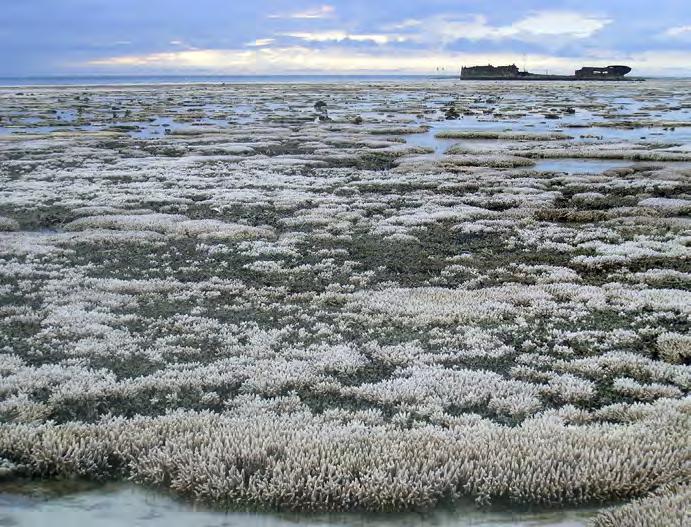
And yet, even in an increasingly hostile ocean, pockets of resilience can still be found. Across the equator from Australia, in another part of the Pacific, the corals of Tubbataha Reefs Natural Park are in comparatively good shape. Within this protected park in the

12
Feature
Bits of coral can be seen amongst the rubble in Queensland, Australia. “Climate change is escalating and is the most significant threat to the [Great Barrier Reef] Region’s long-term outlook,” the Australian government wrote in its Great Barrier Reef Outlook Report last year.
In a 2016 study, Oregon State University researchers concluded that this patch of corals off of Australia’s Heron Island was likely bleached by a combination of stressors, including heavy rain, high water temperatures, and a herpes-like coral virus.
As the ocean absorbs 90% of the extra heat generated by humans and roughly a quarter of our carbon dioxide emissions, its waters are getting hotter and more acidic.
© Oregon State University
© Shutterstock/Pascal Vosicki
Philippines, you can find snapper and sweetlips intermingling with whale sharks, tiger sharks, sea turtles, and marble rays against a kaleidoscopic backdrop comprising 360 species of coral.
By preserving places like Tubbataha, coral reefs can become more resilient in the face of climate change. At the same time, the ocean itself can be used as a tool for mitigating greenhouse gas emissions. Ocean-based solutions could provide 21% of the emissions reductions needed to limit global warming to 1.5°C by 2050, according to a report released last year by the High Level Panel for A Sustainable Ocean Economy, a group of 14 world leaders. The only question is: How do we do it?
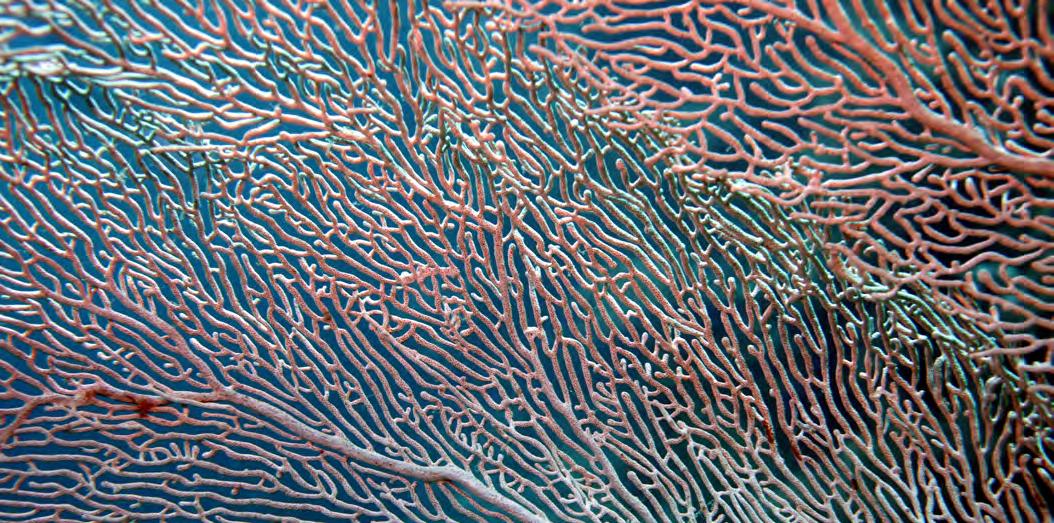
Oceana has answers. In the following pages, you’ll read about Oceana’s three-pronged approach to attacking climate change by protecting carbon-sequestering habitats, supporting sustainable fisheries, and campaigning against expanded offshore drilling.

SPRING 2020 | Oceana.org13
Tubbataha Reefs Natural Park is home to about half of the world’s known coral species, as well as 600 species of fish, 100 species of birds, and 11 species of sharks.
Colorful corals and fish are seen here in Jessie Beazley Reef, which forms part of the Tubbataha Reefs Natural Park.
© Flickr/q phia
© Flickr/q phia
1. Oceana protects carbonsequestering habitats like mangroves and kelp forests.
Mangroves are coastline-hugging trees that thrive in warm, shallow, salty waters. Their waxy leaves peek out above the water, but below the surface is where the magic happens. There, you’ll find a tangle of roots and, below that, a thick layer of soil capable of capturing roughly four times the amount of carbon that tropical forests store. This is because mangrove soils tend to be deeper than other forest soils, and their low levels of oxygen help store carbon more efficiently.

These trees are the true superheroes of the sea. They act as nurseries for baby fish and provide shelter to a variety of marine animals, many of which hold commercial value. They trap sediments and filter wastewater before it is discharged into the ocean. They even act as a natural shield, protecting people from the worst of the storms that have been plaguing coastal communities with greater frequency and intensity as oceans heat up.
“Communities with more extensive mangrove forests experience significantly lower losses from exposure to cyclones than communities without mangroves,” the High Level Panel concluded in its report.
Mangroves are strong, but they aren’t invincible. It’s estimated that up to half of the world’s “blue carbon ecosystems” – a category that includes mangrove forests, salt marshes, and seagrass beds – have been degraded or converted into other applications, like carbonintensive shrimp farms or rice fields.
In the Philippines’ Manila Bay, the
more damage.
devastation has been far greater; nearly 99% of the mangroves in this area have been decimated since the beginning of the 20th century. Mangroves store carbon that may have built up over hundreds or even thousands of years, and yet, when they’re destroyed, it takes mere decades for greenhouse gases to seep back out into the environment.
To protect what’s left of the Manila Bay mangroves, Oceana is campaigning to prevent a development project that would mow down hundreds of mangroves
and convert part of the bay into land. San Miguel Corporation – the largest company in the Philippines by revenue – wants to build an airport in Bulacan province, just outside of Manila. This development, called the New Manila International Airport, would displace hundreds of coastal families and cause irreparable damage to habitats, fisheries, and the livelihoods of local artisanal fishers.
Oceana’s team in the Philippines is building a groundswell of
14
Feature
This photo of mangroves in Florida’s Crystal River was taken in October 2010 during Oceana’s Gulf of Mexico expedition, which was carried out to assess the long-term impacts of the Deepwater Horizon oil rig explosion. Mangroves are highly sensitive to oil, and some cleanup techniques can cause even
© Oceana/Carlos Minguell
opposition to the project by collaborating with local allies and scientists that want to protect Manila Bay. Oceana has also launched an online petition to stop land reclamation along the coast. These “dump-and-fill” infrastructure projects threaten marine biodiversity and disturb fragile coastal ecosystems.
Like mangroves, seaweeds like kelp also sequester carbon –
but only when they sink to the seafloor. As a partner of Bloomberg Philanthropies’ Vibrant Oceans Initiative, Oceana is working in Chile to stop the overexploitation of brown kelp, a type of seaweed that’s typically used in food additives and cosmetics.
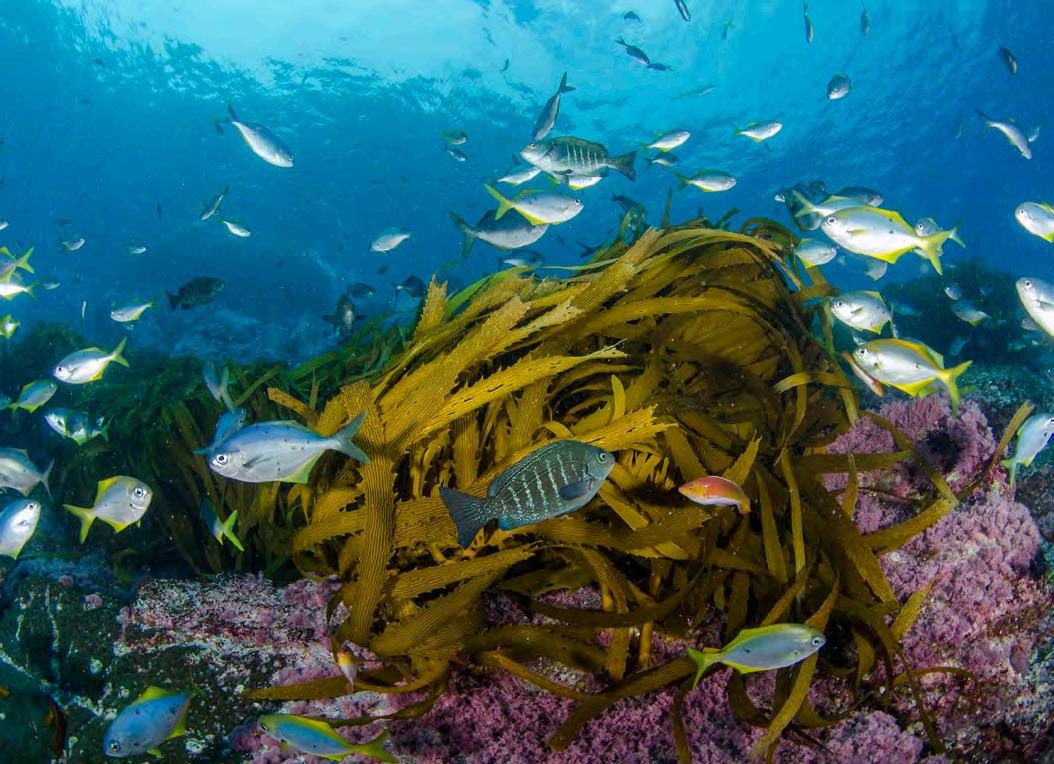
As the largest artisanal “fishery” in Chile, kelp supports thousands of jobs, but the industry could come crashing down if extraction
continues at current unsustainable rates.
Oceana’s goal is to get the Undersecretary of Fisheries to adopt a management plan by 2023 that keeps kelp extraction within healthy levels. This will help preserve harvesters’ jobs long-term while also keeping more kelp in the ocean, allowing the algae – and the carbon it sequesters – to naturally sink to the seafloor.
Kelp is an important carbon-sequestering species. It may look like a plant, but it’s actually a type of seaweed (and therefore an algae), which belongs to a different kingdom. Kelp don’t have roots that absorb nutrients; rather, they use holdfasts – root-like structures – to latch onto surfaces.
SPRING 2020 | Oceana.org15
As the largest artisanal “fishery” in Chile, kelp supports thousands of jobs, but the industry could come crashing down if extraction continues at current unsustainable rates.
© Oceana/Eduardo Sorensen
2. Oceana supports sustainable fisheries that yield low-carbon seafood.
In the context of climate change, science-based fisheries management is more vital than ever. Warming waters are creating a refugee crisis in the ocean, causing fish to go where they normally wouldn’t. At times, when commercially important species have crossed geopolitical boundaries, “fish wars” have been fought over who owns the rights to these resources.
Tropical fish from the Caribbean have been spotted off the U.S. coast of Georgia. Blue whiting from Iceland are increasingly popping up closer to Greenland. And zooplankton – a major food source for many sea creatures – have been shifting poleward by at least 40 kilometers per decade since the mid-1800s.

“Temperature is one of the most pervasive factors affecting a wide
range of species all around the world,” said Oceana Science Advisor Dr. Malin Pinsky (whose research and views on climate change are highlighted in the previous section, on pages 8 and 9).
He added, “Warming makes it harder, in effect, for fish and other marine animals to breathe.
As temperatures go up, their metabolism and heart rate goes up, and they demand more oxygen.”
To make matters worse, warming waters are compounded by other problems like pollution, overfishing, habitat loss, higher amounts of acidity, and less oxygen in the water. Heat, when combined with low oxygen and limited food, can stunt the growth of fish and make them less resilient.
There’s a link between sustainable fisheries and climate change adaptation: By campaigning to reduce overfishing, Oceana is helping marine life withstand a harsher environment.
“Overfished species are particularly vulnerable to climate change,” Pinsky explained. “Reducing overfishing and giving species a chance to recover may be our best chance of ensuring that fisheries are still viable in the future.”
In addition to supporting sustainable fisheries management, Oceana endorses the Paris Agreement, which has the potential to protect 3.3 million metric tons of ocean catch – more than the average annual catch of Norway – as well as $4.6 billion in fishing revenue, according to a study led by Oceana Board Member Dr. Rashid Sumaila.
Oceana is also working to end bottom trawling, the most fuelintensive and destructive fishing method that exists. To date, Oceana has protected millions of square kilometers of ocean habitat from this harmful type of fishing.
As an added benefit, the safer and more sustainable a fishery is, the
16
Feature
©
Anchovies can be a sustainable seafood choice. In Spain’s Bay of Biscay, Oceana successfully advocated for the closure of the anchovy fishery after it collapsed due to overfishing and other factors in the mid-2000s. With time, the population recovered and the fishery was once again opened in 2010.
Shutterstock/evantravels
more ethically a low-carbon source of protein can be provided to a growing global population.
Compared with other sources of protein, like beef and pork, most seafoods have a significantly lower environmental impact.
“In comparison to land-based agriculture, wild fisheries produce a modest amount of greenhouse gases and require virtually no freshwater or arable land,” Alexandra Cousteau, senior advisor to Oceana, said while addressing government officials, business leaders, and scientists at the Our Ocean conference in Norway
“At Oceana, we know that if we rebuild ocean abundance, we can feed the world.”

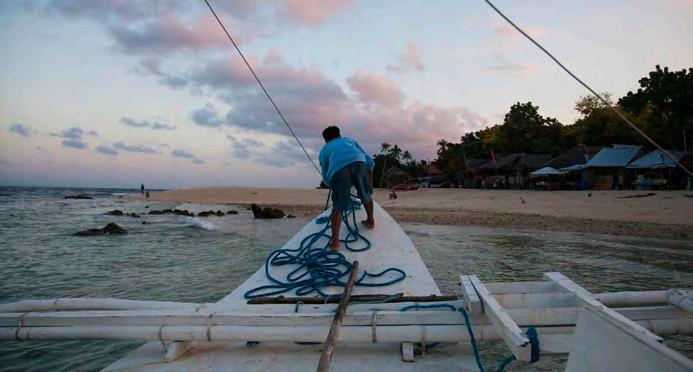
SPRING 2020 | Oceana.org17
last fall.
Reducing overfishing and giving species a chance to recover may be our best chance of ensuring that fisheries are still viable in the future.
– Dr. Malin Pinsky, Oceana Science Advisor
Fishers in Santa Catarina, Brazil target tainha, an important fishery that’s known in English as mullet. Following declines in the fish population, Oceana successfully campaigned for quotas that limit the catch of tainha in Brazil, ushering in more sustainable, science-based fisheries management.
The type of boat used by small-scale fishers in the Philippines is typically referred to as a banca Compared with gas-guzzling bottom trawlers, fishing boats like these are less fuel-intensive.
© Ocean/Jenn Hueting
“ “
© Oceana/Matias Quinteros
April 20 marks the 10-year anniversary of the Deepwater Horizon oil rig explosion in the Gulf of Mexico. In this photo from August 2010, darkness looms over the horizon as hydrocarbon testing is performed off the coast of Mississippi.
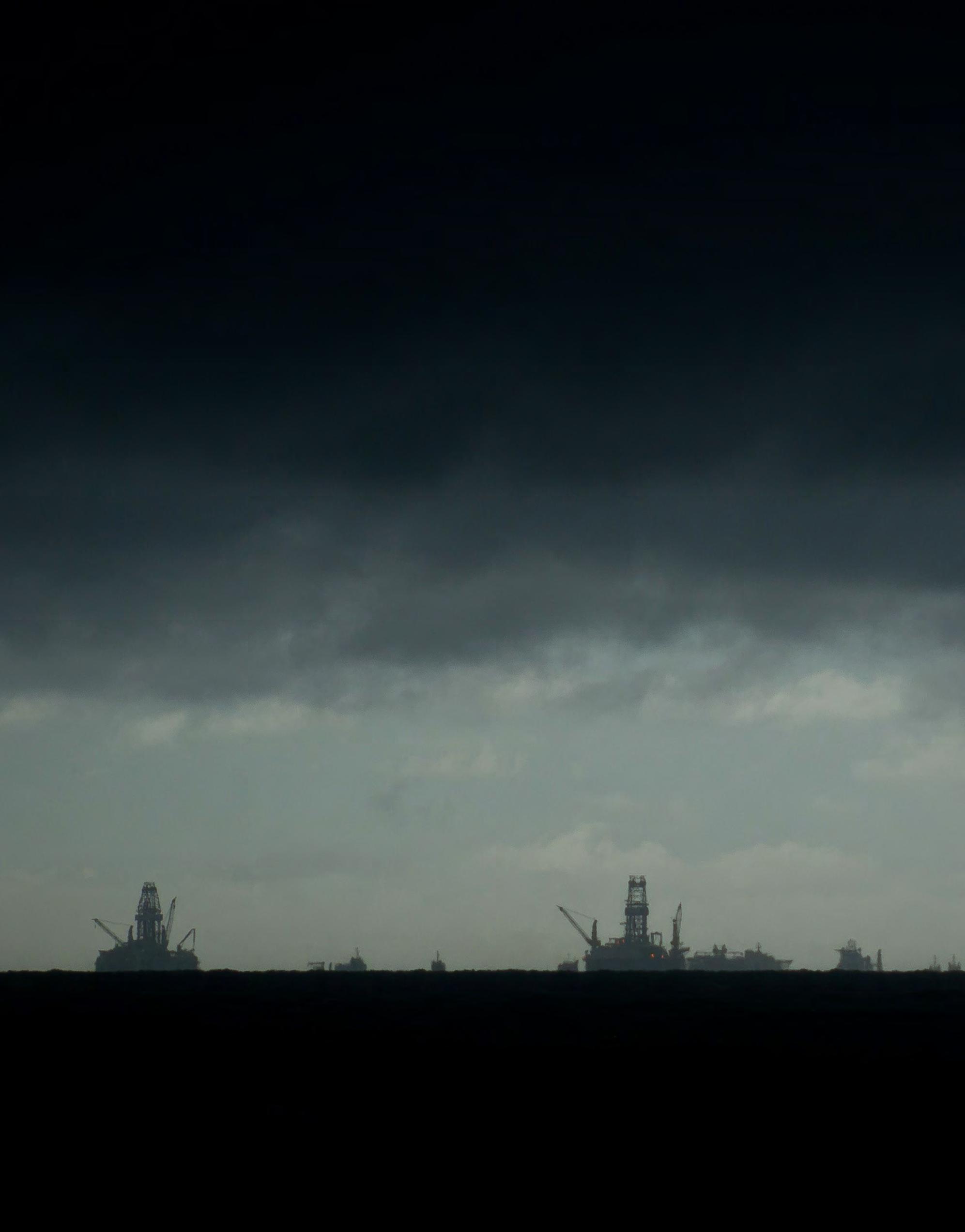
Feature 18

19 © Oceana/Carlos Suárez
It’s no secret that offshore drilling takes a toll on the environment. It’s a sizable contributor to carbon dioxide emissions, and an underreported generator of methane, a powerful greenhouse gas.
Not to mention, there’s the constant threat of oil well blowouts. An Oceana report showed that at least 6,500 oil spills occurred in U.S. waters between 2007 and 2017, but despite their frequency, clean-up methods are generally ineffective and have remained largely unchanged since the late 1980s. This means that oceans and marine wildlife are no safer than
they were when BP’s Deepwater Horizon rig exploded, unleashing the worst environmental disaster in U.S. history.
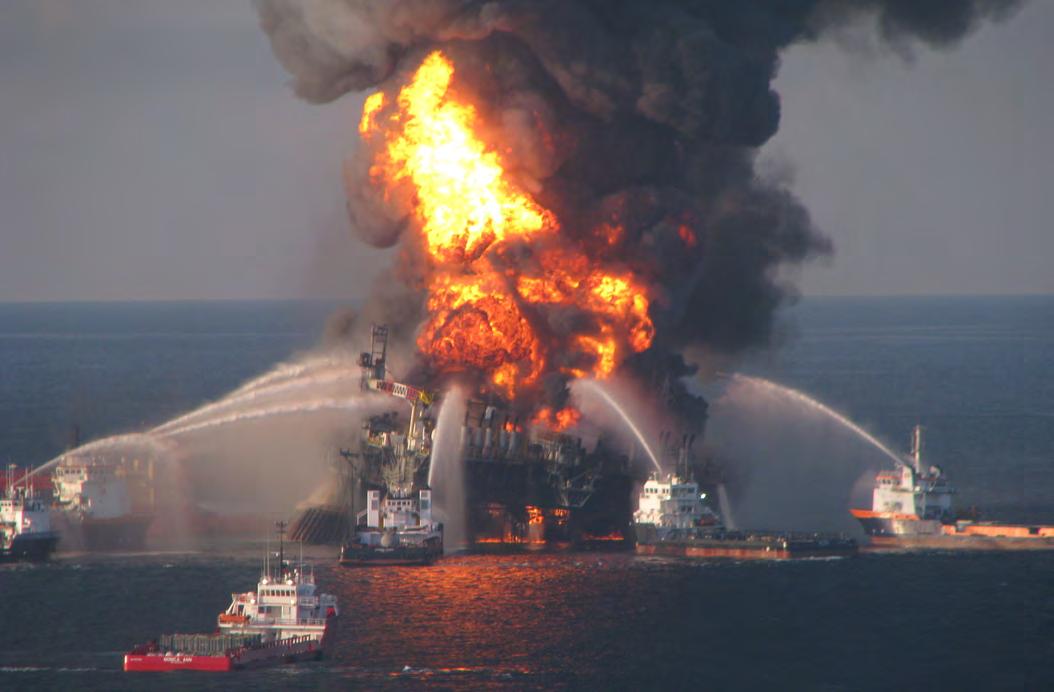
Belize recognized the seriousness of these dangers. In December 2017, following years of campaigning by Oceana, the country made history by passing an indefinite moratorium on offshore drilling in national waters. This secures greater protections for the Mesoamerican Barrier Reef – a UNESCO World Heritage Site and the second largest reef in the world, after Australia’s Great Barrier Reef.
This was an enormous victory for Oceana and Belize. However, the threat of offshore drilling looms elsewhere in the world, including the U.S., where President Donald
Trump announced plans to open nearly all federal waters to oil and gas development. If the President’s plan moves ahead, the fallout would be disastrous: An additional 46 billion metric tons of greenhouse gas emissions would be discharged into the atmosphere, according to an assessment by the Center for American Progress (CAP).
“Put another way, such an increase is the equivalent of the yearly emissions from nearly 10 billion cars – nine times as many cars as are on the road worldwide today,” CAP wrote.
Last April, the state of New York issued a loud and clear rebuke to that plan when Governor Andrew Cuomo signed a bill to prohibit offshore oil drilling and
20
Feature
Emergency responders battle the blazing remnants of the Deepwater Horizon oil rig. Multiple Coast Guard helicopters, planes, and cutters came to rescue the rig’s 126-person crew. Eleven workers died, and millions of barrels of oil were released into the ocean.
© US Coast Guard
3. Oceana campaigns against expanded offshore oil and gas drilling.
associated infrastructure in state waters. Cuomo isn’t the only one taking a stand, either. Nine states have laws on the books against offshore drilling, and every East and West Coast governor – including Democrats and Republicans alike – has opposed expanded offshore drilling along their coasts.
“If we are to avert the worst impacts of climate change, we cannot afford open season for oil drilling on our oceans,” said Diane Hoskins, campaign director at Oceana. “Along the coast, citizens, businesses, and elected officials are united in opposition to offshore drilling, including over 380 communities that have passed formal resolutions.”
Until President Trump’s offshore drilling plan is completely revoked, Oceana will continue to campaign against it to prevent the damage before it’s done.
of the reserve, where fishing is permitted. In turn, both the fishers and the fish benefited.
While Tubbataha is now well protected, other areas in the Philippines are still vulnerable to future harm. That’s why Oceana, with the support of Bloomberg Philanthropies’ Vibrant Oceans Initiative, is looking to establish a marine protected area in a coralrich region of the Philippines within the next few years. By protecting the diverse array of corals and fish that live in healthy reefs, the damage caused by global warming and other stressors can be lessened.
In some cases, carefully designed MPAs can help corals evolve to withstand higher temperatures over time, according to other research led by Timothy Walsworth at the University of Washington and coauthored by Pinsky.
“Corals are facing a gauntlet over the coming years and decades from
warming oceans, but we found that reef conservation in general can really boost corals’ ability to evolve and cope with these changes,” Pinsky said.
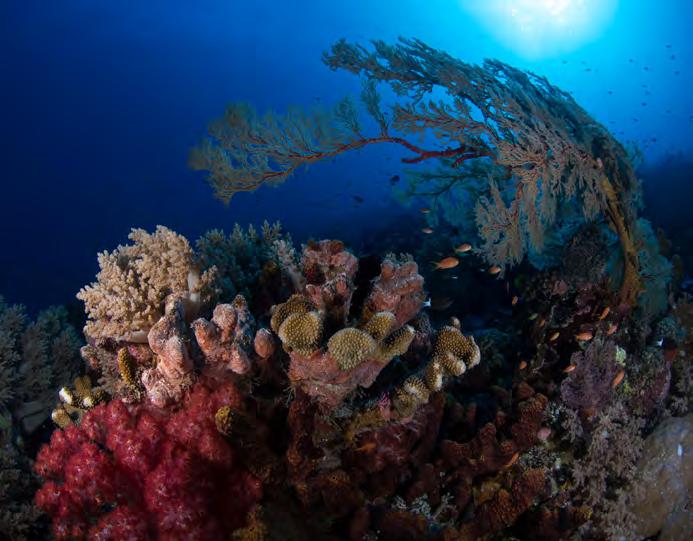
“There is strength in diversity, even when it comes to corals. We need to think not only about saving the cooler places, where corals can best survive in the future, but also the hot places that already have heat-resistant corals. It’s about protecting a diversity of habitats, which scientists hadn’t fully appreciated before.”
The Great Barrier Reef is a cautionary tale of the harm that climate change can inflict, but the story doesn’t have to end there. This latest research paints a picture of what marine ecosystems can look like when we act to preserve habitats, restore abundance, and inject some color and life back into our oceans. Together, we can tell that story and give the ocean the happy ending it deserves.
The future of coral reefs is in our hands.
In the Philippines, where 90% of surveyed corals range in condition from poor to fair, the colorful corals of Tubbataha Reef are faring better. This may come as a surprise, considering that the reef and its residents suffered the effects of “blast fishing,” a destructive, dynamite-detonating method that kills everything within a 30- to 100foot radius (9 to 30 meters). In the 1980s, at the height of blast fishing in the region, the seafloor was left scarred and coral reefs were reduced to rubble.
But the reef managed to make an impressive comeback, thanks to the area being declared a no-take zone in 1995. With time, several fish populations recovered, causing a “spillover effect” into areas outside
SPRING 2020 | Oceana.org21
The Tubbataha Reefs Natural Park “is an excellent example of a pristine coral reef with a spectacular 100-meter perpendicular wall, extensive lagoons, and two coral islands,” according to UNESCO.
© Shutterstock/AlexRoseShoots
From California’s Butterfly Bank to Belize’s coral reefs, Oceana protects vital marine habitats
A squat lobster rests on a fragile glass sponge. This photo was taken during Oceana’s Southern California expedition in 2016.
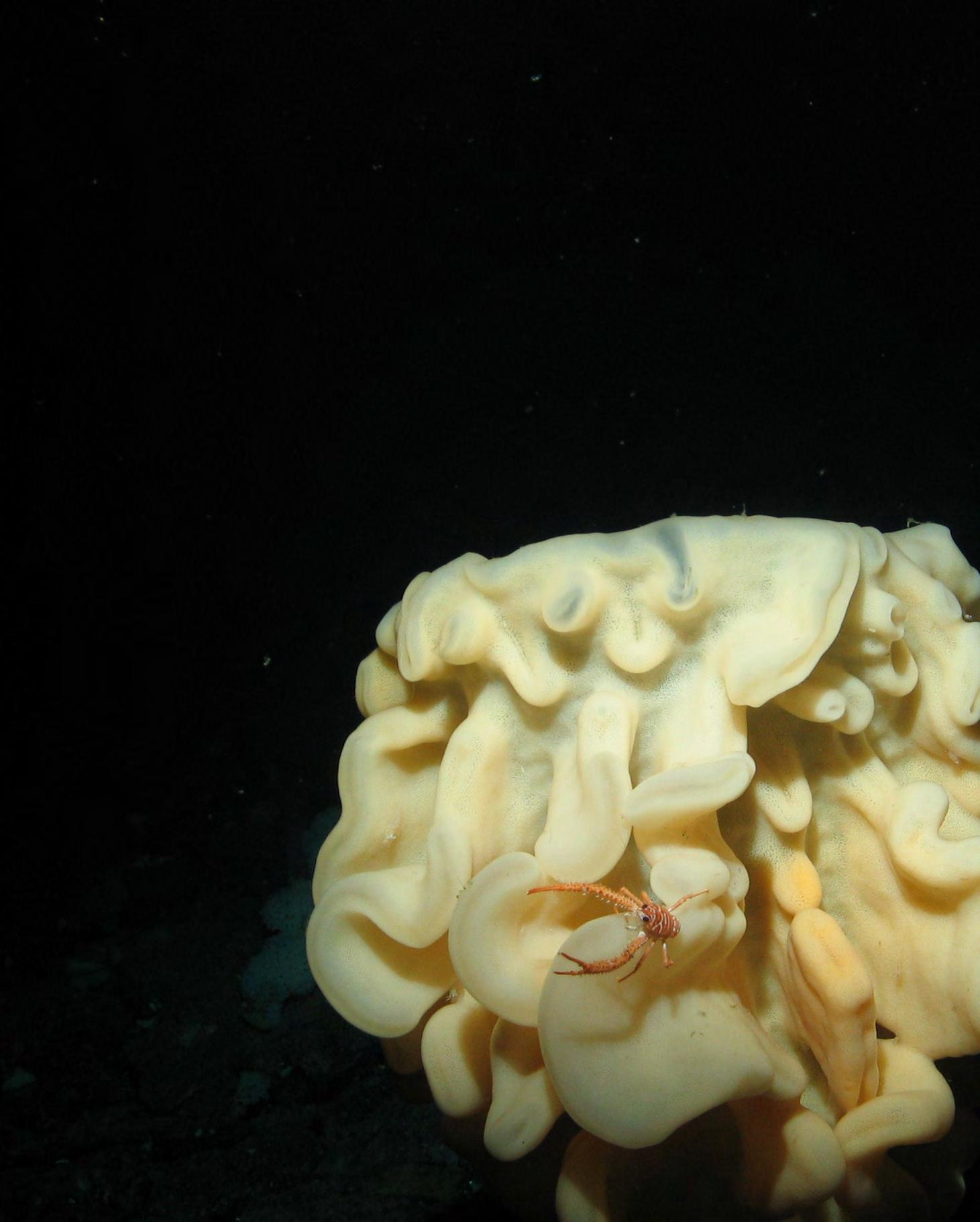
22 Feature
© Oceana
If you charter a boat from San Diego and sail 120 kilometers (75 miles) west, you’ll find yourself floating above a place called Butterfly Bank. Named for the insect its seamounts resemble when viewed from an aerial map, the bank’s slopes and sheer rock cliffs are fluttering with life deep below the surface.
A variety of corals, sponges, and sea pens make their home here, in the cold, dark recesses of the Pacific. Orange and yellow gorgonians sway gently in the current. Bubblegum corals stick out of the seafloor like sore thumbs. Squat lobsters perch atop white laced sponges, and spiny red stars sprawl out lazily on rocks.
Today, we can admire these incredible life-forms in highdefinition photos, but up until just a few years ago, no one had ever
surveyed them with underwater cameras. This means that these creatures have largely remained a mystery, hidden from human view but not immune to human impacts. That changed in 2016, when Oceana embarked on a five-day research expedition off of Southern California in collaboration with two other partners: Marine Applied Research and Exploration (MARE) and the Channel Islands National Marine Sanctuary (CINMS).
Five areas were explored, including Butterfly Bank. This area was particularly vulnerable because, at the time, no regulations were in place to prevent bottom trawls from bulldozing its pristine habitat. These colorful corals and sponges aren’t just nice to look at, either. Together, they form a landscape that provides breeding and feeding grounds to many commercially important species of rockfish, as well as lingcod, sole, and other sea creatures. Once damaged, these slow-growing corals and sponges can take hundreds or thousands of years to recover – if at all.
Armed with all the images and data they needed to make a compelling case, Oceana staff returned to shore and continued campaigning for the protection of vital habitats off of California, Oregon, and Washington. The big payoff arrived on New Year’s Day 2020, when regulations to protect 90% of West Coast waters from bottom trawling – an increase from the 48% of waters that were previously protected – went into effect.
Marine animals and habitats aren’t the only ones reaping the benefits of these regulations: Fishers also prosper. The deal, which was approved by the Pacific Fishery Management Council and finalized by NOAA Fisheries, facilitated the reopening of certain fishing grounds
that had closed in 2002 to help overfished rockfish recover. The
species bounced back faster than expected, proving that conservation areas and catch limits not only help rebuild ocean abundance, but also help fishers who depend on healthy oceans for their livelihoods.
“The decision to protect over 140,000 square miles of additional seafloor habitat off the U.S. West Coast from bottom trawling is a win-win for ocean conservation and fishermen,” said Ben Enticknap, Pacific campaign manager and senior scientist with Oceana. “Healthy oceans rely on a healthy seafloor and these new conservation areas will ensure that commercially important fish and other ocean animals, like deep-sea corals, octopus, crab, and sea stars, can thrive into the future.”

This habitat victory is a classic example of Oceana’s “freeze the footprint” approach to halting destructive fishing in its tracks. It allows fishers to continue working in most waters where trawling has previously occurred – the area known as the “footprint.” The Oceana Approach protects key areas within the footprint that contain fragile habitats, such as seamounts, canyon heads, and coral gardens, while also banning trawling in all areas outside the footprint.
Around the world, Oceana wins key habitat victories, thanks in no small part to the generous support of Bloomberg Philanthropies, the Wyss Foundation, and other funders who are listed in Oceana’s annual report, which is viewable online at oceana.org/publications/ annual-reports. In the following pages, you’ll see a snapshot of some of the rich habitats Oceana has protected in recent years. Let’s dive in.
SPRING 2020 | Oceana.org
Belize
As previously mentioned in the climate change feature (starting on page 10), Belize banned offshore oil drilling indefinitely in December 2017. This measure was preceded two years earlier by permanent protections for the Mesoamerican Barrier Reef, a site that Charles Darwin once called “the most remarkable reef in the West Indies.” There are around 450 sand and mangrove cayes within this reef complex, as well as a number of rare corals. One of its most famous features is the Great Blue Hole, a massive underwater sinkhole and popular diving spot that’s visible from space. In addition to the offshore oil moratorium, Oceana advocated for a bottom trawling ban, which went into effect in Belizean waters in 2010.
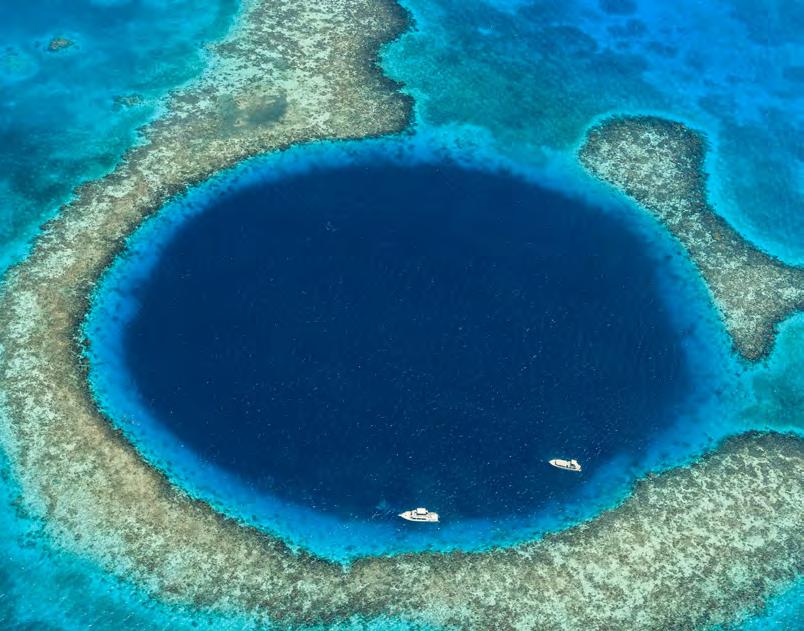
Brazil
Like Belize, Brazil has also protected part of its waters from destructive fishing methods in recent years. The southernmost state of Rio Grande do Sul passed legislation in September 2018 to ban bottom trawling, representing a sweeping change of course in what had previously been the most trawled area in Brazil. However, unlike Belize, Oceana and its allies have had to defend those protections, which are opposed by trawlers. An important milestone came last December, when a justice on Brazil’s Supreme Court denied the fishing industry’s motion of injunction, which sought a reopening of the fishery. In his decision, Justice José Celso de Mello Filho said the bottom trawling ban was an important achievement that will reduce the destruction of ocean habitats. It’s good for local communities, too. One year after the ban was enacted, local and small-scale fishers reported seeing an increase in their landings.

24
Feature
© Shutterstock/Kota Irie
© Oceana
Belize’s Great Blue Hole is a massive sinkhole that measures about 300 meters (1,000 feet) wide and 125 meters (400 feet) deep. It forms part of Belize’s Lighthouse Reef, and experienced divers from around the world flock here to swim amongst the giant underwater stalactites.
Fishing vessels are pictured in Rio Grande do Sul, which used to be one of Brazil’s most important fishing states until harmful practices put the industry at risk of collapse. In 2018, Oceana successfully campaigned for the passing of a statewide sustainable fisheries law.
CanadaNearly 14% of Canada’s waters are safeguarded through marine protected areas or other interim measures. One such place is the Banc-des-Américains, an MPA off of Quebec’s Gaspé Peninsula that Oceana was instrumental in securing last year. This area provides habitat to commercially important fisheries, such as crab and shrimp, as well as depleted ones, like cod and redfish. Atlantic wolffish and North Atlantic right whales can also be found in these waters – and both are in danger of disappearing. Only about 400 North Atlantic right whales remain, including fewer than 100 breeding females. In addition to protecting habitats, Oceana is working to reduce the primary threats these whales face: ship collisions and fishing gear entanglements.
Chile
In recent years, Chile has proven itself to be a world leader in habitat conservation. Following extensive campaigning by Oceana, the country banned bottom trawling from all 118 of its seamounts and established marine parks in 25% of its national waters. Juan Fernández Archipelago – one of the areas benefiting from these protections – is home to endemic species like the eponymous Juan Fernández fur seal and spiny rock lobster. Roughly 62% of the reef fish in Juan Fernández and Desventuradas, another protected area, are endemic. In order to give these unique species a secure future, it’s vital to protect the habitats that support them.


SPRING 2020 | Oceana.org25
© Oceana/Eduardo Sorensen
The Juan Fernández fur seal is endemic to Chile’s Juan Fernández and Desventuradas archipelagos. The species was hunted for its fur in the 18th and 19th centuries and was believed to be extinct by 1900, but in 1965, a small population was spotted on the Juan Fernández islands. Today, it is considered a recovered species.
© iStock/RLS Photo
A striped pink shrimp is pictured in Canada’s Gulf of St. Lawrence, which contains the Banc-des-Américains MPA. Habitat-forming corals and sponges, forage fish like capelin and herring, and the endangered North Atlantic right whale can all be found in this region.
Peru
Peru protects less than 1% of its ocean – but that could soon change. Oceana has been campaigning for the creation of a vast reserve that would encompass an underwater mountain range, nicknamed the “underwater Andes,” that formed tens of millions of years ago. The unique local currents and hot spring vents surrounding these seamounts churn up nutrients and create a cozy habitat for a variety of marine life, including some species that are unlikely to be found anywhere else on earth. Here, you can find protected animals, including blue whales and leatherback turtles, as well as important deep-sea species like cold-water corals and cod. The Nazca Ridge National Reserve would begin about 100 kilometers off of Peru’s Ica coast and stretch towards Easter Island. Peru’s government announced last October that it was committed to the reserve’s establishment, and its formal creation is expected in the first half of this year.


Spain
Spain’s Cabrera National Park became the second-largest marine national park in the Mediterranean last year, thanks to more than a decade of Oceana campaign work and research expeditions throughout the area. It is the first time that Spain has given maximum legal protection to deep-sea corals, as well as the migratory routes of whales and dolphins. Yellow tree corals, lush kelp forests, bluefin tuna, devil rays, and the critically endangered Balearic shearwater all stand to benefit from these new protections.
26 Feature
© Shutterstock/Christian Vinces
A humpback whale breaches off the coast of Peru’s northwestern Piura region. Peru set a goal of protecting 10% of its ocean by 2020, and the creation of Nazca Ridge National Reserve would go a long way towards meeting that objective.
Perched atop a bed of Neptune grass, these rocks in Spain’s Cabrera National Park are covered in green algae, brown algae, red calcareous algae, and sponges. This park provides the highest level of legal protection for threatened marine life, including corals, dolphins, and whales.
© Oceana/Carlos Minguell
A common octopus in Cabrera National Park is surrounded by Mediterranean rainbow wrasses, as an Oceana diver observes in the background.
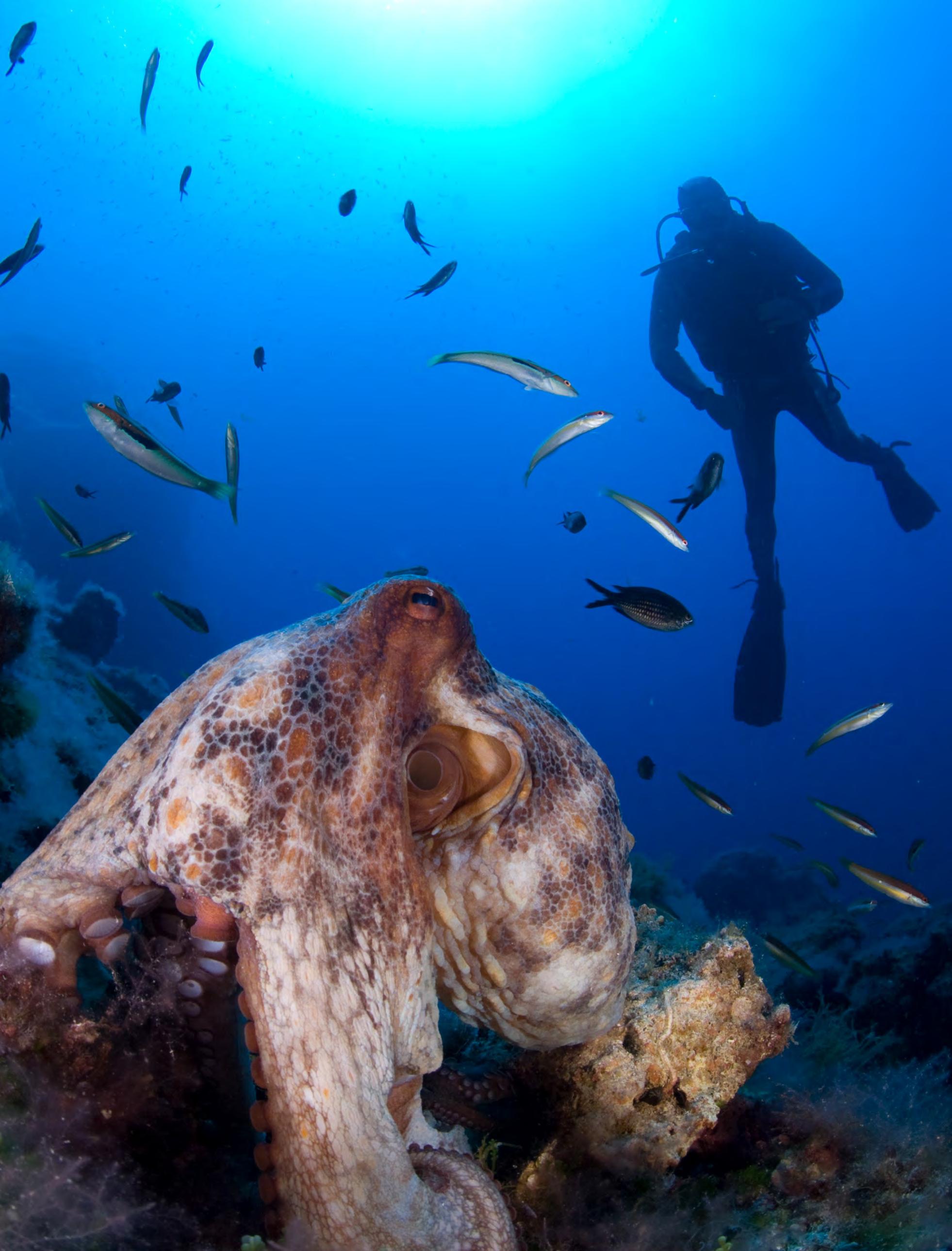 © Oceana/Carlos Suárez
© Oceana/Carlos Suárez
27
A diver explores an underwater cave off of Gozo island during the first of Oceana’s Malta expeditions in 2015. The two expeditions enabled Oceana to document hundreds of species, large reefs of cold-water corals, and caves discovered 300 meters (1,000 feet) below the surface.

Malta
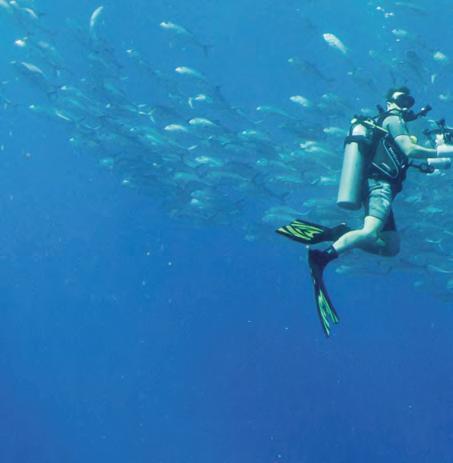


Oceana’s expeditions to the waters surrounding Malta helped convince the government to classify 35% of its ocean as protected in 2018. Sandbanks, cold-water coral reefs, and roughly 90 underwater caves were mapped out during two expeditions in 2015 and 2016. Researchers witnessed a wealth of marine life in this region, including species that hadn’t previously been recorded in the Mediterranean. They also saw rhodoliths (calcareous red algae) that had been visibly damaged by bottom trawling and mooring, further bolstering Oceana’s call for improved habitat protections in Malta’s waters.
The Philippines
Benham Bank is an underwater “treasure,” in the words of Oceana Senior Advisor Alexandra Cousteau, who visited the region east of Luzon in 2016. These rich waters serve as spawning grounds for bluefin tuna – a prized species – and are also home to twilight reefs, whales, dolphins, sharks, and rays. The corals were found to be in pristine condition, with up to 100% coral cover in some areas. Prior to the Philippines making Benham Bank an MPA in 2018, at the urging of Oceana, these waters were vulnerable to bottom trawling and other potential threats, like mining. Now, these habitats stand a better chance of thriving well into the future.

28 Feature
© Oceana/Carlos Minguell
© Oceana/UPLB
An Oriental maori wrasse is seen on a coral reef in Benham Bank, the Philippines. Benham Bank is blanketed with coral assemblages, sponges, and algae in what is known as the mesophotic zone, found at depths of up to 150 meters (500 feet).
part of the ocean’s future.









part of the
future.
SPRING 2020 | Oceana.org29
Visit oceana.org/legasea for more information. Email plannedgiving@oceana.org or call (202)
to request our
Join
Be
ocean’s
Join the LegaSea Circle by including a gift for Oceana in your will, trust or beneficiary designation. You can help restore and protect marine wildlife and habitats for years to come, while enjoying financial benefits for yourself or your loved ones.
833.3900
LegaSea Circle brochure.
the circle…
Visit oceana.org/legasea for more information. Email plannedgiving@oceana.org or call (202)
to request our
Be
Join the LegaSea Circle by including a gift for Oceana in your will, trust or beneficiary designation. You can help restore and protect marine wildlife and habitats for years to come, while enjoying financial benefits for yourself or your loved ones.
833.3900
LegaSea Circle brochure. Join the circle…
Our victories over the last year
U.S. finalizes protections for whales and sea turtles in California-based fishery U.S. West Coast fishery council blocks return of harmful longlines
Mexico provides public access to vessel tracking data
Canada modernizes its Fisheries Act
Canada becomes first G20 country to ban the shark fin trade
Chile publishes its vessel tracking data for fishing fleets, promoting transparency at sea
New York prohibits offshore drilling
Canadian government bans industrial activity in marine protected areas


Oceana wins lawsuit to protect vulnerable dusky sharks in U.S. waters
Canada creates Banc-des-Américains Marine Protected Area
30
Oceana/Tim
©
Calver
Supporter Spotlight
Entrepreneur Elizabeth Wahler takes the reins of Oceana’s SeaChange Summer Party
Elizabeth Wahler grew up in the “Crown of the Sea,” a coastal city in Southern California called Corona del Mar. It was here that she fell in love with the ocean, and it was just a few miles away, in Laguna Beach, where she attended her first Oceana SeaChange Summer Party in 2009 and discovered a way that she could help protect her own backyard.
Over the years, Wahler – now the chair of SeaChange –has deepened her commitment to marine conservation. She has helped to raise millions of dollars for Oceana and cement SeaChange’s status as one of the premier fundraising events in Orange County.
As the founder and CEO of Kiére Media, a digital marketing and software agency, Wahler brings valuable experience to the table. She specializes in brand storytelling and integrated marketing, and advises companies and nonprofits on a variety of matters, from crafting brand strategy to optimizing user experience.
A former journalist, Wahler joined the SeaChange team as media chair in 2010. She wasted no time launching an ambitious project: introducing live interviews to the SeaChange red carpet at a time when practically no one else – not even Facebook or Twitter – had done so.
She later joined SeaChange’s executive committee, and in 2017 became co-chair of the event along with Valarie Van Cleave, the founder of SeaChange and current chair of Oceana’s Board of Directors. Van Cleave recently stepped down as co-chair of SeaChange after a decade of leadership.
Wahler’s new role as the sole leader of SeaChange was announced last year at a donor event overlooking the Pacific. She remembers it clearly, because she was preparing to make a speech when an unexpected visitor turned up.
“I see this beautiful, majestic humpback whale come out of the water in all its glory and do a full flip. It was quite a show,” she recounted. “It was the first whale I’ve seen in its entirety. It was spectacular and just reminds me why I chose to work with Oceana.”
Wahler said she decided to support Oceana for three reasons: It’s a lean and efficient organization, it uses
Wahler takes heart that the conversation surrounding single-use plastics is evolving. “It is changing from one of convenience to one of living more sustainably,” she said. “If we were taught to toss, we can be taught to reuse.”
proven methods to drive results, and its mission is more pressing than ever.
“I love that Oceana wins,” Wahler said. “And even when they don’t, they still move the needle by taking effective, measurable action. I admire Oceana for being so laserfocused on results, and its dedication to protecting and preserving our oceans.
“We’re running out of time to save our oceans. We need to get everyone involved in the conversation so that we can have that – no pun intended – sea change.”
SeaChange plays a significant role in not only starting that conversation, but keeping it going, she said. The fundraiser has been named the “best gala in Orange County,” which is no small feat in a place reputed for its star-studded soirées.

“When people say SeaChange is the best – when there are hundreds of charity events to choose from and hundreds of ways to spend your money – it’s really humbling and fuels me to continue to strive for excellence in being of service to our oceans,” Wahler said.
She plans to build on SeaChange’s success and attract more allies who lead by example. Her goal for 2025 is for over half of the luxury brands that participate in SeaChange’s silent auction to have a proven track record in sustainable production.
SPRING 2020 | Oceana.org31
© David Tosti
Ask Dr. Pauly What is ecosystem-based fisheries management?

Of all the questions this column has attempted to answer, the most difficult is “What is ecosystembased fisheries management?”
One reason for this is that ecosystem-based fisheries management (EBFM) means different things to different people. Also, there is a debate – largely useless – between people who advocate for EBFM and even more ambitious folks who aim more broadly for ecosystem-based management (EBM).
Consider these “Principles of EBM” as commonly defined in the conservation community:
1. Maintain the structure and function of ecosystems;
2. Include human values (and use) of these ecosystems;
3. Be cognizant that these systems are dynamic and change a lot;
4. Must be based on a shared vision of all stakeholders;
5. Be centered around science that is supplemented by constant learning.
In other words, EBM as defined here means talking to everyone, considering everything, making no choices, and doing nothing. The term has devolved toward vacuity.
This is similar to “sustainability,” which could be taken to mean things being done in such a way that they could remain more or
less the way they are forever (or at least for a long time). Sustainability then devolved to “sustainable growth,” which is an oxymoron because something that grows (e.g. an economy, or fisheries catches) cannot continue to do so forever, or even for a long time.
Let’s be serious: Fisheries exploit fish and invertebrate species that are embedded in ecosystems, i.e. a community of plants, animals, and
other living organisms, together with the non-living components of their environment, found in a particular habitat and interacting with each other.
Thus, because of the feeding interactions within ecosystems, fisheries modify the ecosystem they operate in by unavoidably reducing the abundance of the species they exploit, e.g. by depriving certain predator species of their prey, or by
32
The northwest Atlantic cod fishery suffered a disastrous collapse in the ‘90s as a result of overfishing and poor management.
© Oceana/Juan Cuetos
removing the predators of certain species. Also, we should mention the habitat modifications caused by trawlers, which flatten the seafloor and kill all the animals that live on it.
In fact, mathematical models exist which allow us to study how reducing one or several species impacts other species. On the basis of such models (and/or biological common sense), some measures are sometimes taken to leave certain fish in the water so that their predators have enough to eat. Thus, for example, some capelin (a small prey fish) are deliberately left in the waters around Iceland so that cod, a very valuable species, have enough food.
However, such explicit considerations – even though they seem obvious – are extremely rare in fisheries management. Rather, fisheries managers have found that it is much easier to allow fishing for all the sought-after species in an ecosystem, and to just mention EBFM or EBM as an aspirational goal.

The excuse that these fisheries managers then give if challenged is that it is too difficult to restrict fishing on forage species so that predator species can feed, to give one example. Notably, the managers would have to extract a fee from the fishers who benefit
from their intervention and allocate it to the fishers who don’t. Thus, for all practical purposes, we will continue to have to rely on singlespecies fisheries management for a long time, if not forever.
However, there are two major things we can do to maintain or re-establish healthy marine ecosystems:

First, we should aim to maintain exploited fish populations at the abundance levels that generate Maximum Sustainable Yield (MSY), i.e., half their unexploited abundance, and/or rebuild overfished to depleted populations to that level.
In many cases, such single-species management can, if applied to the major exploited species, reestablish functioning ecosystems. This would be an improvement over the present situation, as the current population levels of such species generally are well below those that will produce MSY.
Second, we should let nature help us. If we create marine reserves with no fishing, the populations therein will recover to levels that are compatible with the abundance of their prey and predators. Nature knows how to manage ecosystems; she has done that for millions of years.
33
Dr. Daniel Pauly is the founder and director of the Sea Around Us project at the University of British Columbia’s Institute for the Oceans and Fisheries, and is a member of the Oceana Board.
Capelin are an important forage fish as well as a staple food in the diets of many seabirds, whales, and larger fish. People in some parts of the world like to eat them, too.
SPRING 2020 | Oceana.org
© Shutterstock/Tatyana Kuchinskaya
Our Ocean 2019
Oceana CEO Andrew Sharpless, Chief Policy Officer Jacqueline Savitz, Senior Advisor Alexandra Cousteau, and other Oceana representatives attended the Our Ocean conference in Oslo, Norway, last October. A number of global leaders were in attendance, including Norway’s Prime Minister Erna Solberg, Norway’s Crown Prince Haakon, former U.S. Secretary of State John Kerry, Palau’s President Thomas Remengesau Jr., and Senegal’s President Macky Sall. Addressing attendees, Oceana called for reductions in plastic production and increased transparency in global fisheries.
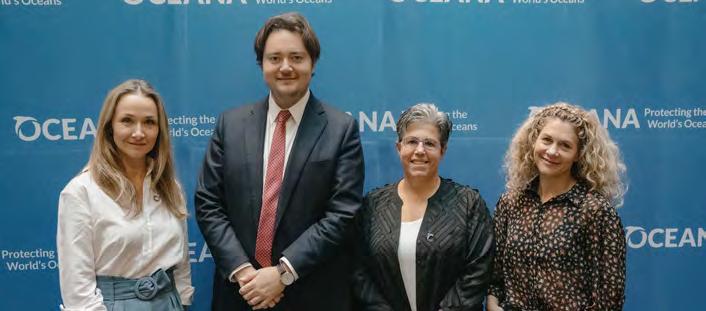



“We are emptying our oceans of fish and filling them with plastic,” Cousteau said during the conference. “In just a few generations we have gone from abundance and biodiversity to scarcity, and from clean and pristine waters to plastic-choked shorelines. This will only get worse, unless we do something now.”
Since 2014, Our Ocean participants have committed more than $27 billion to ocean conservation and protected more than 25 million square kilometers of ocean.
34
Events
All photos by Ilja C. Hendel
Oceana organized a media workshop and panel discussion the day before Our Ocean began
Oceana Senior Advisor Alexandra Cousteau, State Secretary for Norway’s Ministry of Foreign Affairs Jens Frølich Holte, Oceana Chief Policy Officer Jacqueline Savitz, and Oceana supporter Cecile Skog
Alexandra Cousteau gave a speech on the need to increase ocean abundance and decrease plastic pollution to save the oceans and feed the world
An Oceana ad on display at the airport in Oslo
Oceana in Zurich
On October 29, nearly 80 guests attended a seminar titled “Reclaiming Our Oceans from Plastic” in Zurich, Switzerland. Graciously hosted by Oceana Board Member Monique Bär, the event was so popular that it had to be relocated to a larger venue, the Chainwork Hub. Leaders in the worlds of European finance and philanthropy – including Raymond Bär, Beate Eckhardt, Marcus Fivian, Sue Jennings, Oliver Karius, Barbara Keller, Carolina Müller-Möhl, Lukas von Orelli, and Bernhard Speiser – mingled with authors, artists, and others who wanted to hear more about Oceana’s plans to address plastic pollution in the sea.








Monique Bär welcomed the crowd and introduced fellow Oceana Board Members Herbert Bedolfe, María Eugenia Girón, and Heather Stevens, then gave the floor to Oceana CEO Andrew Sharpless.
Sharpless shared Oceana’s strategy for reducing the flow of plastic into the world’s oceans by targeting single-use plastic production. The discussion was lively, and guests lingered long after his presentation, enjoying the apéro riche and exchanging thoughts on how best to restore the health and abundance of the world’s oceans.
SPRING 2020 | Oceana.org35
All images by Katharina Wernli Photography
Oceana Board Member and host Monique Bär
Oceana CEO Andrew Sharplessw
Chantal and Alexander Senft
Michael Lindenmayer and Prabhat Pani Alex von Mueffling and Ray Bär
Dr. Ian Schwieger and Dr. Anne Schwieger
Barbara Keller
The event was moved to a larger location due to an overwhelming response
Oceana’s UK Receptions
In early December, Oceana’s International Board of Directors and Executive Committee gathered in London for the final board meeting of 2019. At the end of each of the two days, environmental allies and local leaders in philanthropy, business, and the arts were welcomed to receptions at the
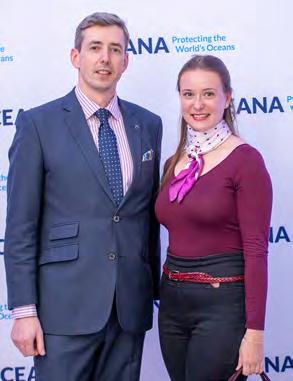
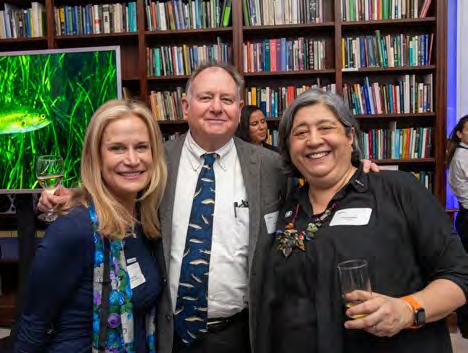
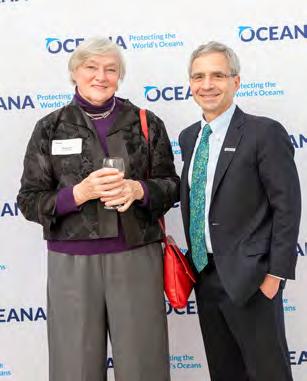
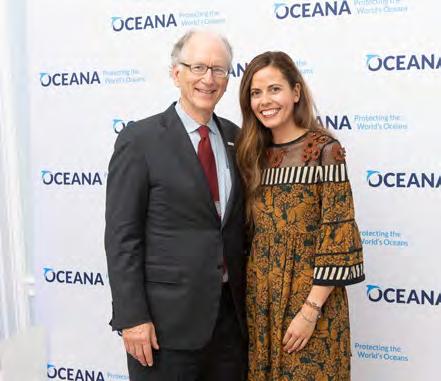


House Terrace and Spencer House.
At this historic venue in the British Academy, Board Member and host Heather Stevens welcomed guests and introduced Oceana CEO Andrew Sharpless. He gave an energetic overview of Oceana and highlighted some of the victories in Europe, including the reform of the Common Fisheries Policy and a ban on deep sea bottom trawling in the waters of the northeast Atlantic. He also explained Oceana’s plastics campaign and concluded with this message: “Oceana brings together technology, science, law, communications, and grassroots engagement. That’s the way we get things done.”
36
Events
Carlton
Carlton House
Oceana CEO Andrew Sharpless (bottom left) with members of Oceana’s International Board of Directors, including the host, Heather Stevens (bottom right)
Nicholas Hardman-Mountford and Pauline Vaskou
Callum Macmillan, Claire Dutton, Francesca Dutton, Rosie Nixon, Board Members Sam Waterston and Susan Rockefeller, and Matt Porteous
Anthea Case and Oceana President Jim Simon Andrew Sharpless and Valentina Marchetti
Board Members Sydney Davis and Beto Bedolfe with Oceana’s Vice President for Peru, Patricia Majluf
All photos by Gregg Allen
Oceana’s guests were welcomed by Lord Jacob Rothschild, under whose chairmanship Spencer House has been carefully restored to its 18thcentury glory. Oceana Board Member David Rockefeller spoke of Oceana’s vision and quoted the mantra shared by him and his wife and fellow Board Member Susan Rockefeller: “Protect what is precious.”


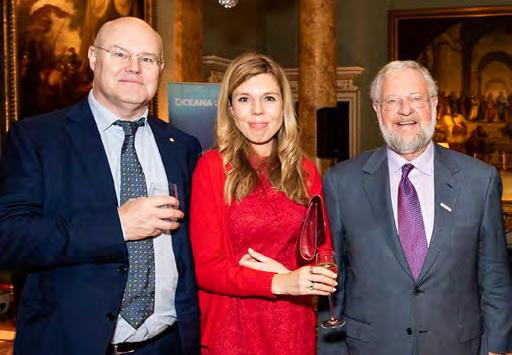
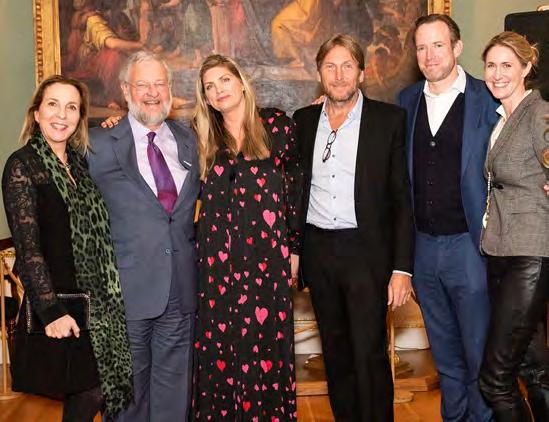
He continued, “To us, three things are most precious: family, art, and nature. Jacob and I first bonded over art, and I’m so thankful we did. But tonight, I’m here for nature.” He then introduced Andrew Sharpless, who spoke of Oceana’s accomplishments and Oceana’s plastics campaign. Afterwards, guests mingled with Oceana Board Members and discussed nature against the backdrop of beautiful art.

SPRING 2020 | Oceana.org37
Spencer House
Oceana CEO Andrew Sharpless with Board Members Sydney Davis, David and Susan Rockefeller, Diana Thomson, Monique Bär, Oceana President Jim Simon, Board Member Valarie Van Cleave, and Board Member Beto Bedolfe
David and Susan Rockefeller with Jacob Rothschild (center)
Jim Simon, Board Member Simon Sidamon-Eristoff, Ben Koerner, and Oceana’s Vice President in Europe Pascale Moehrle
Susan and David Rockefeller, Kate and Jochen Zeitz, Rupert Adams, and Valerie Keller
Peter Hall, Oceana Senior Advisor Carrie Symonds, and David Rockefeller
All photos by Alex Lloyd
Chef’s Corner Sea Scallops

38
© Romulo Yanes
How to find sustainably-sourced scallops
Atlantic sea scallops were in big trouble in the mid-‘90s. Much like several other species that were being critically overfished at the time, scallops were becoming scarcer and scarcer, with scallop fishers’ collective catch plummeting by millions of pounds in three short years.
Then, they were thrown a lifeline. Several scallop-rich areas were closed to fishing, giving these filter-feeding bivalves a chance to bounce back. In time, they swelled in both size and number, and the Atlantic sea scallop fishery is now the world’s largest and most valuable wild scallop fishery.
There’s a problem, though. Scallops are typically caught with dredges, which are essentially heavy metal cages that scrape the seafloor when they’re dragged across it.
However, some scallops are plucked from the sea by divers, ensuring that marine habitats are left intact. These scallops tend to be bigger because they’re hand-picked, with only the choicest mollusks making the cut. Unfortunately, better traceability is needed, because it’s difficult to verify that products carrying the “diver scallop” label were actually caught by divers.
While true diver scallops can be hard to come by, there are other options. The Monterey Bay Aquarium’s Seafood Watch guide lists farmed sea scallops as a “best choice.” This form of aquaculture requires no added feed and little to no chemicals or antibiotics, so it’s a safe option the next time you want to prepare a sustainable scallop dinner.
Mark Bittman’s Seared Scallops with Pan Sauce
From How to Cook Everything: The Basics
Makes 4 servings Time: 15 minutes
Ingredients:
3 tablespoons butter
1 tablespoon olive oil
1½ pounds sea scallops
1 tablespoon minced garlic
½ cup dry white wine or water, or more as needed
2 tablespoons chopped fresh chives Juice of 1 lemon Salt and freshly ground black pepper
Instructions
Cut 2 tablespoons of the butter into peasized pieces, put it on a small plate, and stick it in the freezer. Heat a large skillet over medium-high heat for 3 or 4 minutes. Add the remaining 1 tablespoon butter and the olive oil and wait for the butter to melt. Pat the scallops dry with paper towels, add them to the pan, and sprinkle with salt and pepper; work in batches if necessary to avoid crowding the skillet. Cook, turning once, until they are well browned on both sides but not quite cooked through, 2 minutes per side (less if the scallops are under 1 inch across; more if they’re over). Transfer the scallops to a plate.
Stir in the garlic, lemon juice, and wine and scrape all the brown bits off the bottom of the skillet with a spatula. Lower the heat to medium and cook until the liquid in the skillet thickens, a minute or two, then whisk in the butter you chilled in the freezer, one bit at a time, to make a creamy sauce, adding another tablespoon or two of liquid if necessary. Return the scallops to the skillet and add the chives. Adjust the heat so the sauce bubbles gently and toss to coat the scallops with the sauce. To serve, transfer the scallops to a platter and spoon the sauce over all.
SPRING 2020 | Oceana.org39
A diver is shown hovering above a bed of Neptune grass off the coast of Spain. This image was captured during Oceana’s 2011 Ranger expedition to the Mediterranean and Atlantic. On this two-month trip, Oceana staff documented the underwater canyons and mountains of Southwestern Europe at depths of up to 800 meters (2,625 feet).

40©
Oceana/Carlos
Minguell

41
This melancholic-looking creature is called the European eelpout, but it isn’t an eel. It’s a type of fish that is also sometimes called the viviparous blenny. “Viviparous” means that this particular species gives birth to live young. The eelpout in this photo was spotted off the coast of Sweden during Oceana’s Quark expedition in 2018. Oceana recently called on Finland and Sweden to designate a joint area to protect the Quark region.
Oceana’s accomplishments wouldn’t be possible without the support of its members.

Global headquarters:
D.C.
| Halifax |
|
| New York |
Go to Oceana.org and give today. 1025 Connecticut Ave NW, Suite 200 Washington, DC 20036 USA phone: +1.202.833.3900 toll-free: 1.877.7.OCEANA You can help Oceana fight to restore our
with your financial contribution. Call us today at 1.877.7.OCEANA, go to our
and click on
today” or use the envelope provided in this newsletter. You can also invest in
by
in your will. Please contact us to find out how. All
to
Washington,
Asia: Manila Europe: Brussels | Copenhagen | Madrid | Geneva | London North America: Belmopan | Ft. Lauderdale | Juneau
Mexico City
Monterey
Ottawa | Portland | Toronto South America: Brasilia | Santiago | Lima
oceans
website www.oceana.org/give
“give
the future of our oceans
remembering Oceana
contributions
Oceana are tax deductible. Oceana is a 501(c)(3) organization as designated by the Internal Revenue Service.
© Oceana/Carlos Minguell







 Andrew Sharpless CEO Oceana
Andrew Sharpless CEO Oceana







 © Oceana/Juan Carlos Calvin
© Oceana/Juan Carlos Calvin





















 © Oceana/Carlos Suárez
© Oceana/Carlos Suárez











































